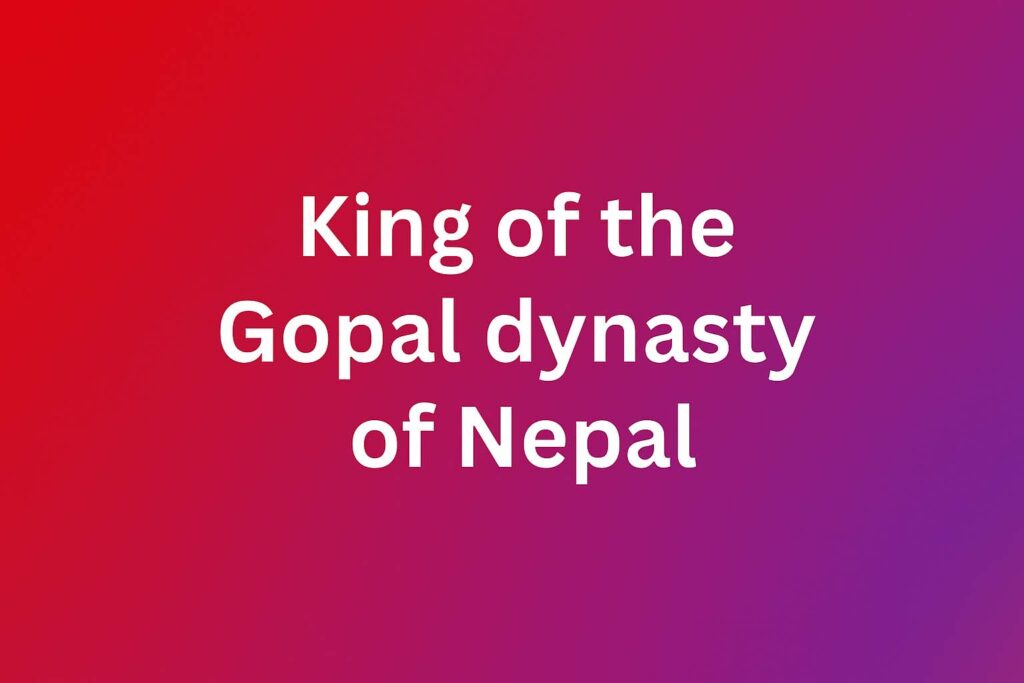The Gopal Dynasty: Nepal’s First Royal Lineage
The Gopal Dynasty is traditionally regarded as the first ruling dynasty of Nepal, predating recorded history and laying the foundation for Nepalese civilization. Known as cowherds or pastoralists, the Gopals were deeply connected to agriculture, animal husbandry, and spiritual devotion. Their reign, though shrouded in legend, is a cornerstone of Nepal’s early historical identity.
Origins and Mythical Beginnings
The Gopals are believed to have migrated from West India, specifically the Saraswati River region, and belonged to the Nip clan. According to folklore:
- The Kathmandu Valley was once a vast lake.
- Manjushree, a sage from China, drained the lake by cutting a gorge at Chovar, making the valley habitable.
- The Gopals arrived alongside Lord Krishna, defeating the Naga tribes and Danasur, and began settling in the fertile valley.
Their name—Gopal—literally means “protector of cows”, reflecting their pastoral lifestyle and agrarian roots.
The Role of Sage Ne Muni
A pivotal figure in Gopal lore is Ne Muni, a sage believed to have lived in the Teku gorge. He was entrusted by the gods to protect Nepal. According to tradition:
- A cow named Brahuri from the Gopal herd offered milk daily at a riverside spot.
- A Jyotirlinga (divine light of Shiva) appeared at the site, killing the Gopal leader who investigated.
- Ne Muni declared the leader’s son, Bhumi Gupta, as king—marking the beginning of the Gopal Dynasty.
This event is also linked to the discovery of the Pashupatinath Temple, one of Nepal’s most sacred sites.
Capital and Territory
The Gopal kings established their capital at Mata Tirtha, located about 4 miles southwest of Kathmandu. Their territory extended:
- East: Dudh Koshi River
- West: Trishuli River
- North: Gosainkunda
- South: Chitlang
They ruled primarily around the Kathmandu Valley, founding settlements in places like Kirtipur, Thankot, Sakhu, Palung, and Changu.
The Eight Kings of the Gopal Dynasty
Historical texts like the Gopal Raja Bansawali and Bhasa Bansawali list eight kings who ruled for over 500 years. Here’s a breakdown:
| No. | King Name | Reign Duration | Notes |
| 1 | Bhumi Gupta | 84–86 years | First king, chosen by Ne Muni |
| 2 | Dharma Gupta / Param Gupta | 91 years | Second king, spiritual and wise |
| 3 | Bhim Gupta | 34–38 years | Known for strengthening agriculture |
| 4 | Bishnu Gupta | 46 years | Promoted Shaivism and temple building |
| 5 | Jaya Gupta | 72–73 years | Expanded settlements and trade |
| 6 | Harsha Gupta | 67–93 years | Longest reign, cultural prosperity |
| 7 | Mani Gupta / Mati Gupta | 37 years | Focused on governance and law |
| 8 | Jita Gupta / Yaksha Gupta | 70–71 years | Last king, childless, overthrown by Mahispals |
Each king was believed to be the son of his predecessor, maintaining a hereditary monarchy.
Religious Contributions
The Gopal kings were devotees of Lord Shiva, practicing Shaivism, though some also followed Vaishnavism. Their spiritual legacy includes:
- Restoration of the Pashupatinath Temple, now a UNESCO World Heritage Site.
- Promotion of Jyotirlinga worship and Vedic rituals.
- Integration of cow worship into cultural norms.
Their religious devotion shaped Nepal’s spiritual identity for centuries.
Lifestyle and Governance
The Gopal Dynasty was rooted in agrarian values:
- Economy: Based on cattle herding, dairy production, and farming.
- Society: Simple communal living, with homes made of wood, clay, and thatch.
- Governance: Early form of absolute monarchy, guided by tradition and spiritual authority.
- Trade: Local barter systems and exchanges with neighboring tribes.
Their rule emphasized sustainability, harmony with nature, and community welfare.
Transition to Mahispal Dynasty
The Gopal Dynasty ended when Jita Gupta, the last king, died childless. This opened the door for the Mahispal Dynasty—buffalo herders from the Abhir clan—to seize power.
- The Mahispals were similar in lifestyle but more militarized.
- They ruled for 161 years, marking a shift in political dynamics.
This transition reflects the fluidity of early Nepalese governance, where dynasties rose and fell based on lineage, strength, and divine endorsement.
Historical Significance
Though much of the Gopal Dynasty’s history is mythical or oral, its impact is undeniable:
- First organized monarchy in Nepal.
- Foundation of Kathmandu Valley civilization.
- Cultural and religious legacy that persists today.
- Symbol of agrarian roots and spiritual devotion.
Their story bridges the gap between legend and history, offering insights into Nepal’s earliest societal structures.
Final Thoughts
The Gopal Dynasty kings were more than rulers—they were custodians of land, culture, and faith. Their reign, steeped in pastoral simplicity and spiritual depth, laid the groundwork for Nepal’s evolution into a vibrant, diverse nation.
[/et_pb_text][/et_pb_column][/et_pb_row][/et_pb_section]






 Uptoday
Uptoday